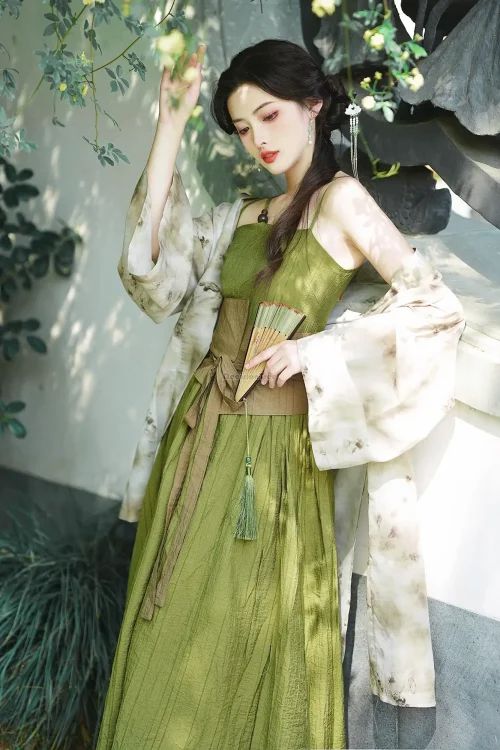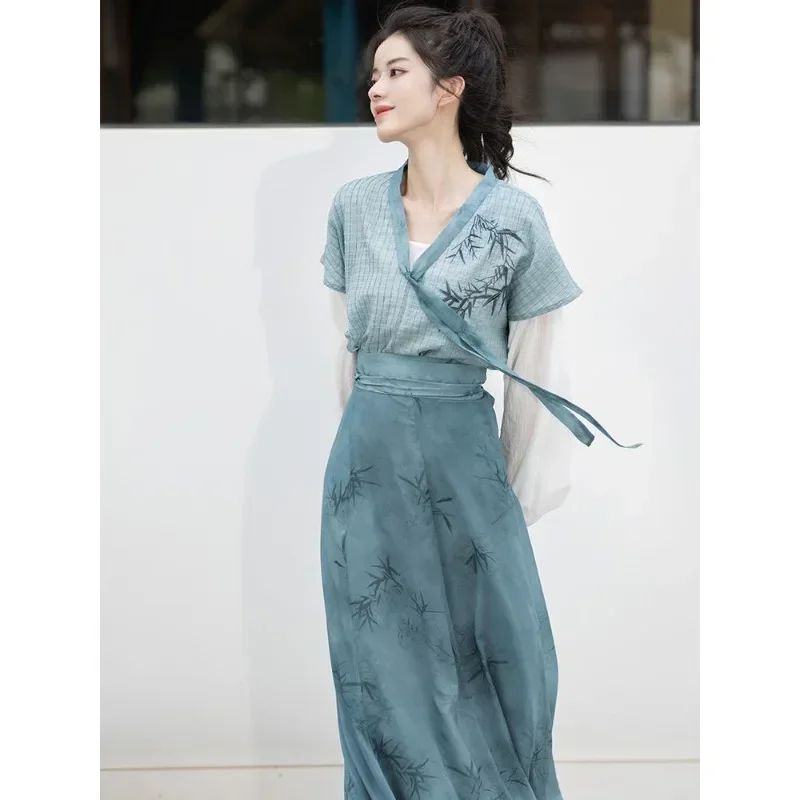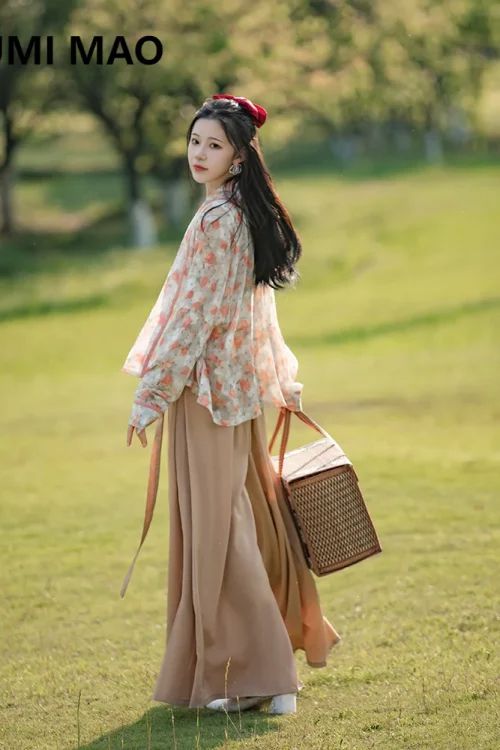The Eco-Friendly Appeal of Hanfu modern: A Sustainable Revival
In the realm of fashion, sustainability has emerged as a pressing concern, prompting designers to explore eco-friendly alternatives. Amidst this movement, the revival of pakaian tradisional Tiongkok, known as Hanfu, has gained traction as a sustainable fashion choice.

Modern Hanfu and Eco-Conscious Materials
Modern Hanfu, while rooted in ancient designs, incorporates contemporary materials and techniques to create garments that are both stylish and environmentally conscious. Natural fibers such as cotton, linen, and silk are favored for their breathability and durability. These materials are biodegradable, reducing the environmental impact of the garment’s eventual disposal.
Traditional Construction Techniques
Furthermore, traditional Hanfu construction techniques emphasize longevity. Garments are often made with multiple layers of fabric, allowing for repairs and alterations over time. This extends the lifespan of the pakaian, reducing waste and promoting a circular fashion economy.
Ethical Production Practices
The production of modern Hanfu also adheres to sustainable practices. Many designers prioritize ethical sourcing of materials, ensuring that the fibers are grown and harvested responsibly. Additionally, traditional dyeing techniques, which utilize natural plant-based dyes, minimize the use of harmful chemicals.
Cultural Heritage and Value
Beyond its environmental benefits, modern Hanfu also promotes cultural heritage. By embracing traditional designs and craftsmanship, it preserves a tangible connection to China’s rich history. This cultural significance adds value to the pakaian, encouraging consumers to cherish and maintain them for generations to come.
Global Resonance
The eco-friendly appeal of modern Hanfu has resonated with consumers worldwide. Its combination of sustainability, style, and cultural heritage has made it a popular choice for those seeking ethical and environmentally conscious fashion. As the demand for sustainable fashion continues to grow, modern Hanfu is poised to play a significant role in shaping the future of the industry.
Kesimpulan
In conclusion, the revival of modern Hanfu represents a convergence of sustainability and cultural preservation. Its eco-friendly materials, traditional construction techniques, and ethical production practices make it a sustainable fashion choice that promotes longevity and reduces waste. Moreover, its cultural significance adds value to the garments, encouraging consumers to appreciate and maintain them for years to come. As the fashion industry embraces sustainability, modern Hanfu is poised to become a leading example of how tradition and innovation can coexist to create a more sustainable and stylish future.
Sustainable Style: Exploring the Environmental Benefits of Hanfu
In the realm of sustainable fashion, the ancient Chinese garment known as Hanfu is experiencing a resurgence, captivating eco-conscious consumers with its timeless elegance and environmental credentials. Modern Hanfu, while rooted in traditional designs, embraces sustainable practices, making it an alluring choice for those seeking both style and environmental responsibility.

Longevity and Durability
One of the key aspects of Hanfu’s sustainability lies in its longevity. Traditionally crafted from natural fibers such as silk, cotton, and linen, Hanfu garments are designed to withstand the test of time. Their durability reduces the need for frequent replacements, minimizing textile waste and the associated environmental impact.
Traditional Production Techniques
Furthermore, the production of Hanfu often involves traditional techniques that prioritize sustainability. Natural dyes derived from plants and minerals are employed, eliminating the use of harmful chemicals that can pollute waterways and harm ecosystems. Artisans also utilize hand-weaving and embroidery methods, reducing energy consumption and minimizing the carbon footprint associated with industrial production.
Incorporating Eco-Friendly Materials
Beyond its inherent sustainability, modern Hanfu designers are actively incorporating eco-friendly materials into their creations. Organic cotton, bamboo fibers, and recycled fabrics are gaining popularity, further reducing the environmental impact of Hanfu production. These materials are not only biodegradable but also offer exceptional comfort and breathability.
Promoting Cultural Heritage
The resurgence of Hanfu also promotes cultural heritage and traditional craftsmanship. By embracing this ancient garment, consumers support artisans who have preserved these skills for generations. This not only ensures the continuity of cultural traditions but also fosters a sense of community and connection to the past.
A Unique Aesthetic
In addition to its environmental benefits, Hanfu offers a unique aesthetic that combines elegance and versatility. Its flowing lines, intricate embroidery, and vibrant colors make it a statement piece that can be dressed up or down for various occasions. Modern Hanfu designers are also experimenting with contemporary silhouettes and patterns, creating a fusion of tradition and modernity that appeals to a wide range of tastes.
Kesimpulan
As consumers become increasingly aware of the environmental consequences of their fashion choices, sustainable fashion is gaining momentum. Modern Hanfu, with its timeless beauty, eco-friendly credentials, and cultural significance, is poised to become a leading force in this movement. By embracing this ancient garment, we can not only express our personal style but also contribute to a more sustainable and ethical fashion industry.
Hanfu for a Greener Future: The Role of Traditional Fashion in Sustainability
In the realm of fashion, sustainability has emerged as a pressing concern, prompting designers and consumers alike to seek eco-friendly alternatives. Amidst this growing awareness, the ancient Chinese garment known as Hanfu has garnered attention for its inherent sustainability.

Aesthetic and Environmental Value
Hanfu, with its flowing silhouettes and intricate embroidery, embodies the essence of traditional Chinese culture. However, beyond its aesthetic appeal, Hanfu also holds significant environmental value. Its construction relies primarily on natural fibers such as silk, cotton, and linen, which are biodegradable and renewable. Unlike synthetic materials, these fibers do not contribute to microplastic pollution or release harmful chemicals into the environment.
Minimizing Waste
Moreover, Hanfu’s traditional production methods minimize waste. The garments are often handcrafted by skilled artisans using techniques passed down through generations. This labor-intensive process ensures durability and longevity, reducing the need for frequent replacements and the associated environmental impact.
Ethical Consumption
Furthermore, Hanfu promotes ethical consumption. Its timeless designs transcend fleeting trends, encouraging wearers to cherish and preserve their pakaian. This approach fosters a sense of responsibility and discourages the disposable fashion culture that contributes to environmental degradation.
Cultural Renaissance
The revival of Hanfu in modern times has not only sparked a cultural renaissance but also ignited a movement towards sustainable fashion. Designers are incorporating eco-friendly materials and production practices into their Hanfu creations, while consumers are embracing the garment as a symbol of both cultural heritage and environmental consciousness.
Connection to Cultural Roots
By embracing Hanfu, we not only connect with our cultural roots but also contribute to a greener future. Its sustainable attributes make it an ideal choice for those seeking to reduce their environmental footprint while expressing their individuality. As the world grapples with the challenges of climate change, Hanfu serves as a reminder that traditional wisdom can provide innovative solutions for a more sustainable fashion industry.
